Went out twice last week firstly early in the week to a village called Daneben south west of
Quedlinburg where Montagu's have bred in the past and then yesterday to the
Concordia-See a little further to the south. Most German Montagu's nest in crops and the area around Quedlinburg and
Halberstadt being open and flat has supported a few breeding pairs in the past, including around Daneben. Not this year though - well if there were some there I didn't see them and they ought to be relatively conspicuous this time of year. The landscape is quite attractive - despite the German attempts to industrialise their countryside with giant wind and solar farms - with the Harz as a backdrop. They don't do hedges here though fields and tracks are bordered by fruit trees all of which are in bloom this time of year. The only ornithological comment worth noting was the presence of Wheatears which seem to be thinly but widely distributed throughout the region. Drove home towards the autobahn through dreary crop fields looking for harriers - I found one - a Marsh Harrier of which there are plenty. A bit of a disappointing day to be honest.
 |
| Daneben landscape |
The Concordia-See is the largest artificial lake in Saxon-Anhalt and it lies 10 - 15 km SW from Quedlinburg. Apart from having lots of water, it is surrounded by reclaimed scrub land and well-drained grassland. There are also lots of poplars and in the past I've seen Golden Oriel here too. Today, however, none seemed to be around and it was left to a supporting cast of 6 Grasshopper Warblers, Corn Buntings and the ubiquitous Whitethroats singing seemingly from every bush. As usual, lots of Red Kites, Marsh Harriers, Kestrels and Buzzards but little else on the bird of prey front - no Black Kites and certainly no Montagu's. None the less an enjoyable visit but on reflection frustrating because there is probably so much more there to see were there the time and information. At the moment I am having to find everything myself which is satisfying but also time consuming.
 |
| Grasshopper Warbler - Concordia-See |
I am wondering where all the Red-backed Shrikes are. A common bird here and I haven't seen one yet - are they late this year or what? Driving home I discovered, less than 1km away, an extensive area of reed bed and damp scrub. This is typical - there seems to be so much more of this type of habitat than in the west Germany or the UK for that matter. It looked most promising but will have to wait for another day.
 |
Whitethroat - Concordia-See
|























